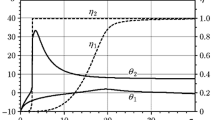Abstract.
A mathematical model of ignition of Mg particles and wires is proposed. It is based on the concept of thermal deceleration of the chemical reaction responsible for ignition. It is modeled to the experimental data obtained for the dependence of the radius of a Mg particle on the limiting temperature of the gas. A possibility of propagation of heat waves under heterogeneous oxidation of a Mg wire exposed to an external flow is shown. The existence conditions are written for the travelling wave solution and the self-sustained wave regime is found. It is numerically shown that the ignition wave can be initiated by temperature distributions of stepwise initial data and of Gaussian-shaped form. It is shown that self-sustained waves are stable with respect to small and finite disturbances.
Similar content being viewed by others
Author information
Authors and Affiliations
Additional information
Received 25 July 1997 / Accepted 13 July 1998
Rights and permissions
About this article
Cite this article
Gosteev, Y., Fedorov, A. Numerical study of heat waves excited by oxidation of a magnesium wire. Shock Waves 10, 287–294 (2000). https://doi.org/10.1007/s001930000058
Issue Date:
DOI: https://doi.org/10.1007/s001930000058




